Toy manufacturing and entertainment company (NASDAQ:MAT) missed analysts' expectations in Q1 CY2024, with revenue flat year on year at $809.5 million. It made a GAAP loss of $0.08 per share, improving from its loss of $0.30 per share in the same quarter last year.
Mattel (MAT) Q1 CY2024 Highlights:
- Revenue: $809.5 million vs analyst estimates of $832.9 million (2.8% miss)
- EPS: -$0.08 vs analyst estimates of -$0.14 (41.8% beat)
- Full year EPS guidance of $1.40 (in line)
- Gross Margin (GAAP): 48%, up from 40% in the same quarter last year
- Free Cash Flow of $5 million, down 99.4% from the previous quarter
- Market Capitalization: $6.41 billion
Known for the creation of iconic toys such as Barbie and Hotwheels, Mattel (NASDAQ:MAT) is a global children's entertainment company specializing in the design and production of consumer products.
Mattel's story began in 1945 as a garage startup. Founded by Harold "Matt" Matson and Elliot Handler to craft picture frames, they later pivoted to dollhouse furniture. The founders' belief in the crucial role of play in a child's development spurred Mattel's shift toward toy manufacturing. This move led to the creation of Barbie, a toy that rapidly gained popularity.
Today, Mattel's portfolio encompasses a variety of toy lines and digital games that encourage imaginative play. Some of its products are also dedicated to educational purposes.
Mattel’s revenue is derived from sales of its toy and game portfolio, film and television content based on its brands (Barbie Movie), and licensing deals. It sells its products through direct-to-consumer sales channels and a retail presence. Mattel's potential lies in its ability to create characters and stories that resonate with children across various cultures.
Toys and Electronics
The toys and electronics industry presents both opportunities and challenges for investors. Established companies often enjoy strong brand recognition and customer loyalty while smaller players can carve out a niche if they develop a viral, hit new product. The downside, however, is that success can be short-lived because the industry is very competitive: the barriers to entry for developing a new toy are low, which can lead to pricing pressures and reduced profit margins, and the rapid pace of technological advancements necessitates continuous product updates, increasing research and development costs, and shortening product life cycles for electronics companies. Furthermore, these players must navigate various regulatory requirements, especially regarding product safety, which can pose operational challenges and potential legal risks.
Competitors in the toy and entertainment industry include Hasbro (NASDAQ:HAS), Funko (NASDAQ:FNKO), and Jakks Pacific (NASDAQ:JAKK).Sales Growth
A company’s long-term performance can give signals about its business quality. Even a bad business can shine for one or two quarters, but a top-tier one may grow for years. Mattel's annualized revenue growth rate of 3.6% over the last five years was weak for a consumer discretionary business. 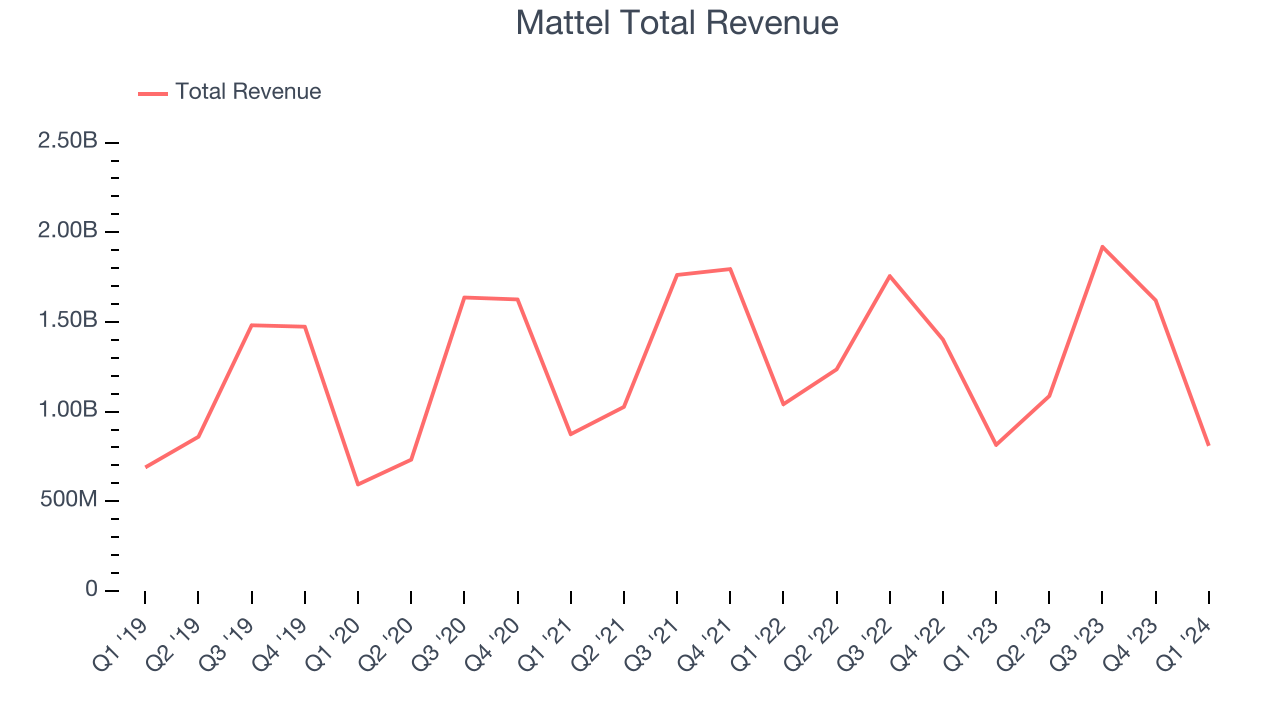 Within consumer discretionary, product cycles are short and revenue can be hit-driven due to rapidly changing trends. That's why we also follow short-term performance. Mattel's recent history shows a reversal from its already weak five-year trend as its revenue has shown annualized declines of 1.7% over the last two years.
Within consumer discretionary, product cycles are short and revenue can be hit-driven due to rapidly changing trends. That's why we also follow short-term performance. Mattel's recent history shows a reversal from its already weak five-year trend as its revenue has shown annualized declines of 1.7% over the last two years.
This quarter, Mattel missed Wall Street's estimates and reported a rather uninspiring 0.6% year-on-year revenue decline, generating $809.5 million of revenue. Looking ahead, Wall Street expects revenue to remain flat over the next 12 months.
Operating Margin
Operating margin is a key measure of profitability. Think of it as net income–the bottom line–excluding the impact of taxes and interest on debt, which are less connected to business fundamentals.
Mattel has done a decent job managing its expenses over the last eight quarters. The company has produced an average operating margin of 10.8%, higher than the broader consumer discretionary sector.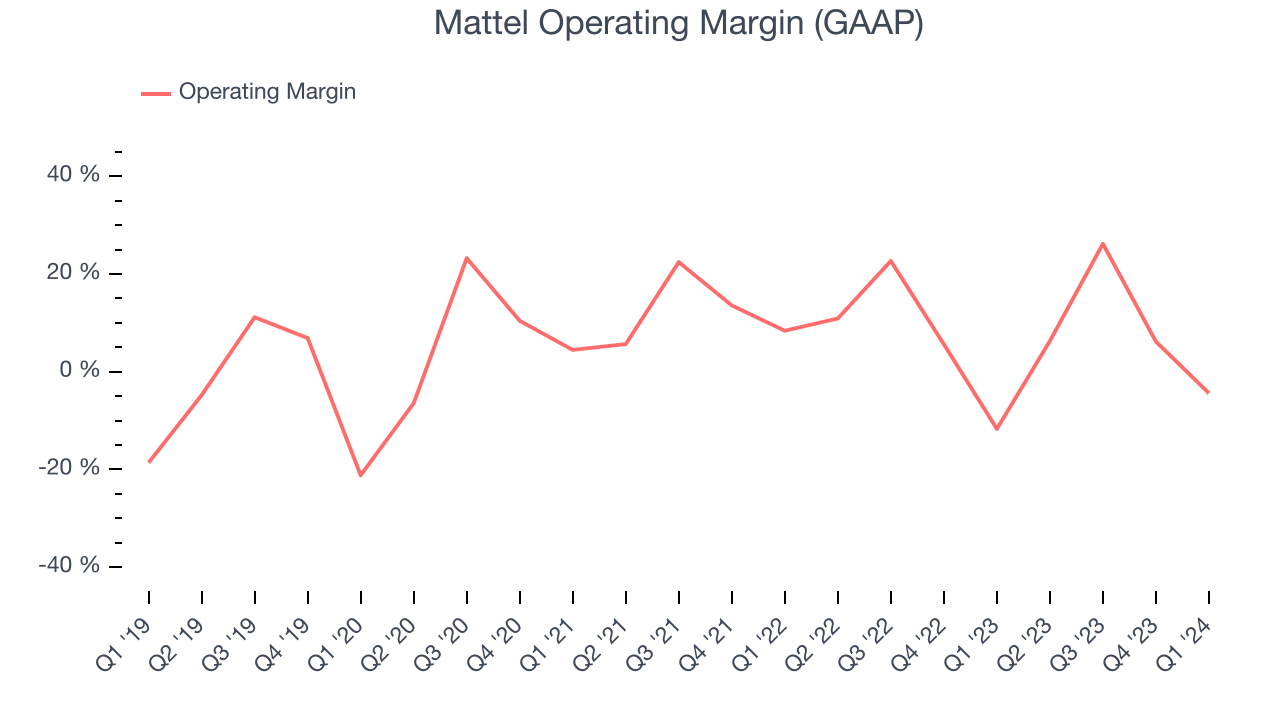
This quarter, Mattel generated an operating profit margin of negative 4.4%, up 7.3 percentage points year on year.
Over the next 12 months, Wall Street expects Mattel to become more profitable. Analysts are expecting the company’s LTM operating margin of 11.7% to rise to 13.1%.EPS
We track long-term historical earnings per share (EPS) growth for the same reason as long-term revenue growth. Compared to revenue, however, EPS highlights whether a company's growth was profitable. 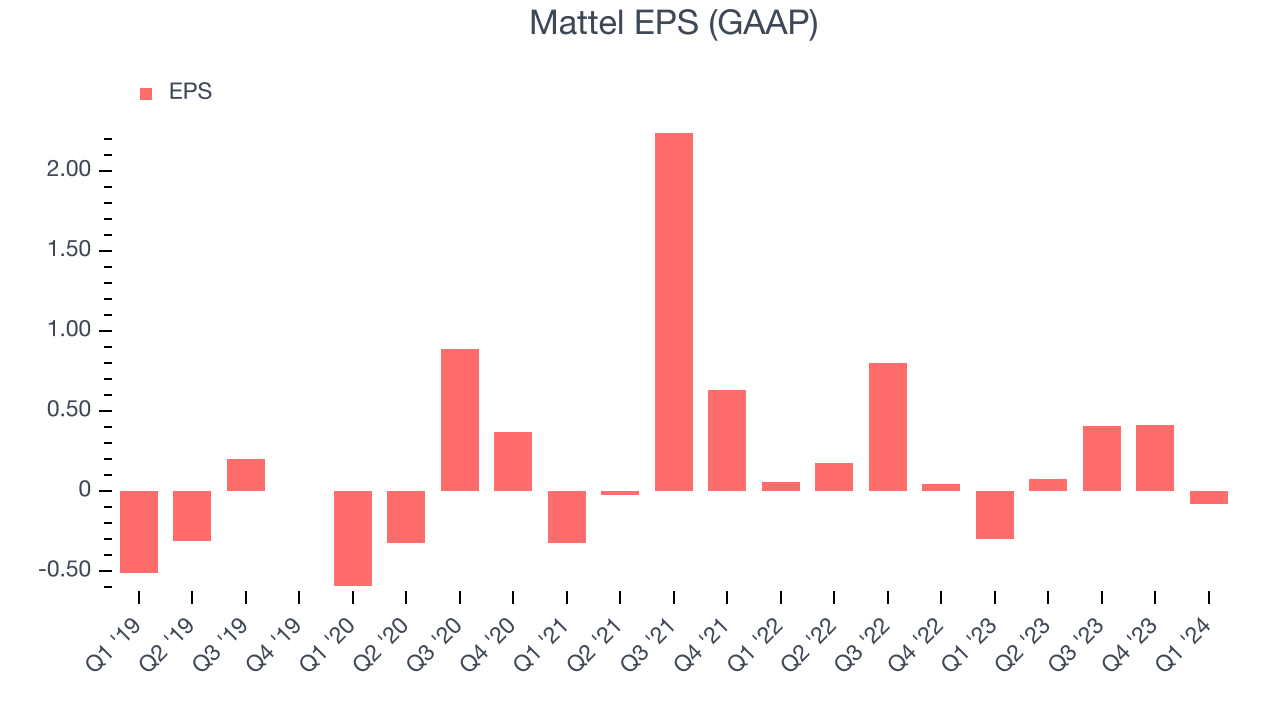
Over the last five years, Mattel cut its earnings losses and improved its EPS by 29% each year. This performance is materially higher than its 3.6% annualized revenue growth over the same period. Let's dig into why.
Mattel's operating margin has expanded 14.2 percentage points over the last five years, leading to higher profitability and earnings. Taxes and interest expenses can also affect EPS growth, but they don't tell us as much about a company's fundamentals.In Q1, Mattel reported EPS at negative $0.08, up from negative $0.30 in the same quarter last year. This print beat analysts' estimates by 41.8%. Over the next 12 months, Wall Street expects Mattel to grow its earnings. Analysts are projecting its LTM EPS of $0.82 to climb by 59.1% to $1.31.
Cash Is King
Although earnings are undoubtedly valuable for assessing company performance, we believe cash is king because you can't use accounting profits to pay the bills.
Over the last two years, Mattel has shown decent cash profitability, giving it some reinvestment opportunities. The company's free cash flow margin has averaged 10.8%, slightly better than the broader consumer discretionary sector.
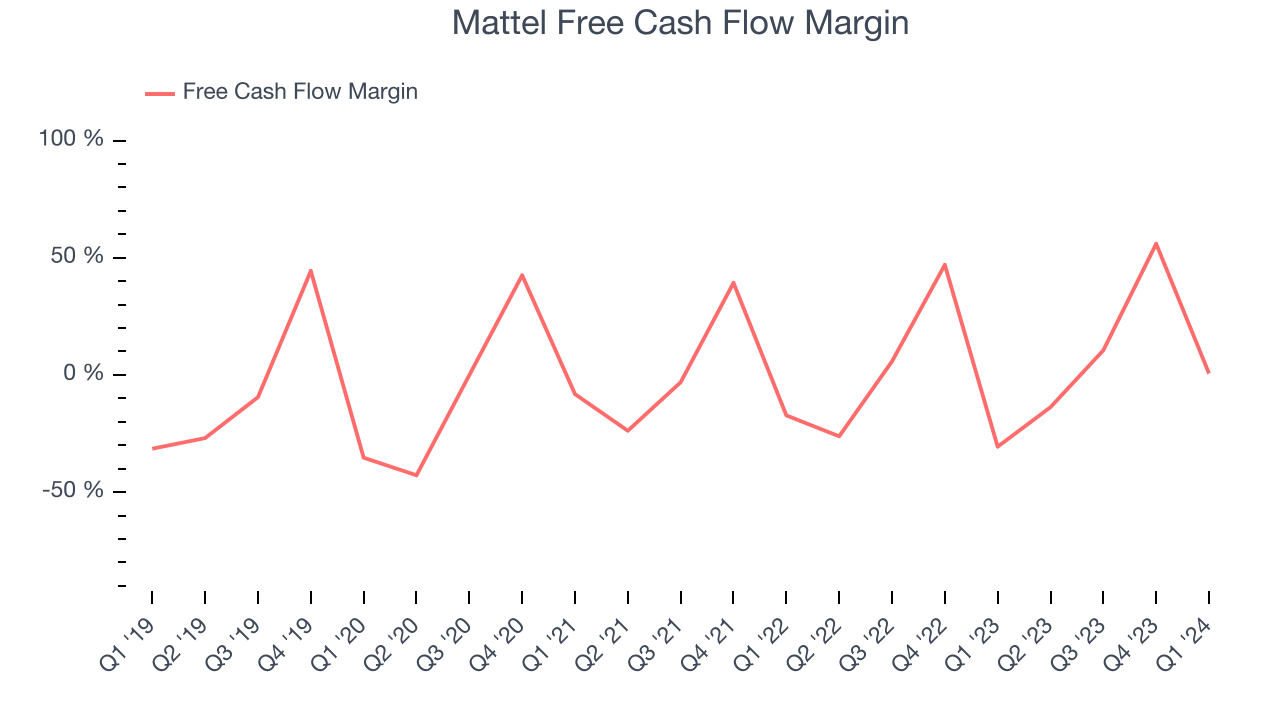
Mattel broke even from a free cash flow perspective in Q1. This quarter's result was great for the business as its margin was 31.2 percentage points higher than in the same period last year.
Return on Invested Capital (ROIC)
EPS and free cash flow tell us whether a company was profitable while growing revenue. But was it capital-efficient? A company’s ROIC explains this by showing how much operating profit a company makes compared to how much money the business raised (debt and equity).
Mattel's five-year average return on invested capital was 14.5%, somewhat low compared to the best consumer discretionary companies that pump out 25%+. Its returns suggest it historically did a subpar job investing in profitable business initiatives.
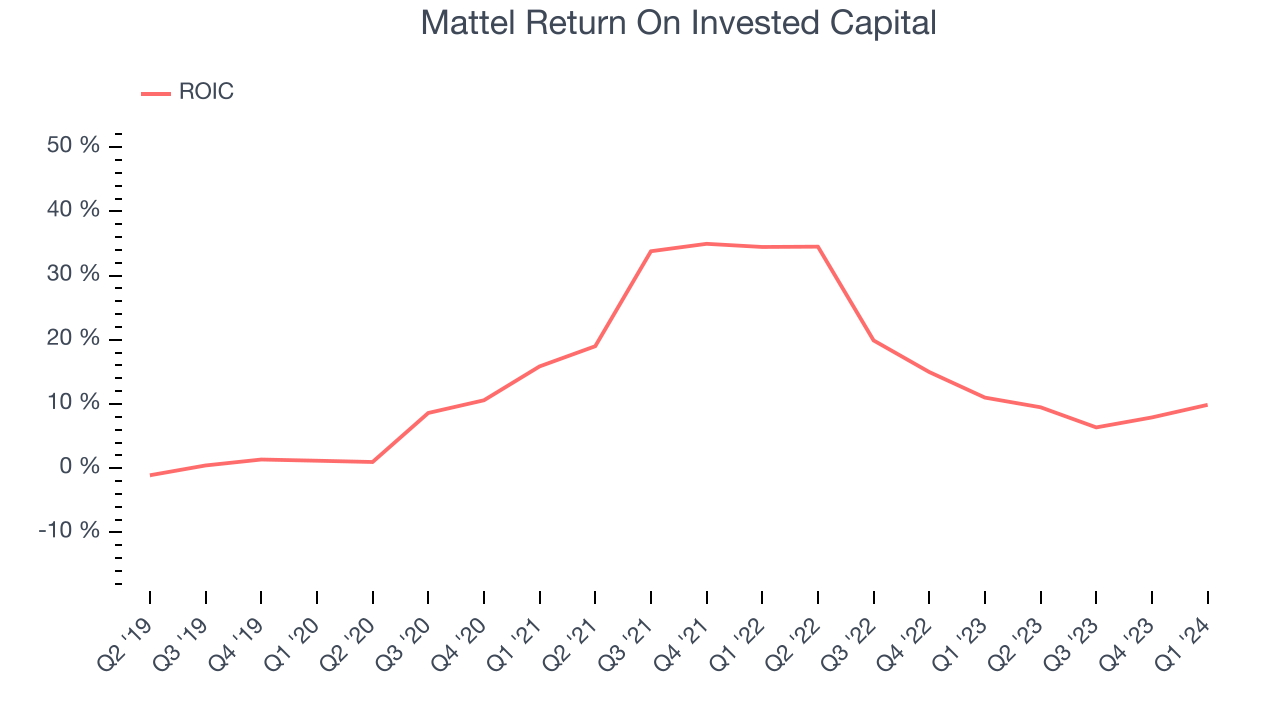
The trend in its ROIC, however, is often what surprises the market and drives the stock price. Over the last few years, Mattel's ROIC averaged 1.9 percentage point increases. This is a good sign, and we hope the company can continue improving.
Key Takeaways from Mattel's Q1 Results
We were impressed by how significantly Mattel blew past analysts' EPS expectations this quarter. We were also excited its operating margin outperformed Wall Street's estimates. On the other hand, its revenue unfortunately missed. Looking ahead, full year EPS guidance was line with expectations. Overall, this quarter's results seemed fairly positive and shareholders should feel optimistic. The stock is up 3.7% after reporting and currently trades at $19.45 per share.
Is Now The Time?
Mattel may have had a favorable quarter, but investors should also consider its valuation and business qualities when assessing the investment opportunity.
We cheer for all companies serving consumers, but in the case of Mattel, we'll be cheering from the sidelines. Its revenue growth has been weak over the last five years, and analysts expect growth to deteriorate from here.
Mattel's price-to-earnings ratio based on the next 12 months is 13.3x. While we've no doubt one can find things to like about Mattel, we think there are better opportunities elsewhere in the market. We don't see many reasons to get involved at the moment.
Wall Street analysts covering the company had a one-year price target of $23.22 per share right before these results (compared to the current share price of $19.45).
To get the best start with StockStory, check out our most recent stock picks, and then sign up for our earnings alerts by adding companies to your watchlist here. We typically have the quarterly earnings results analyzed within seconds of the data being released, and especially for companies reporting pre-market, this often gives investors the chance to react to the results before the market has fully absorbed the information.
